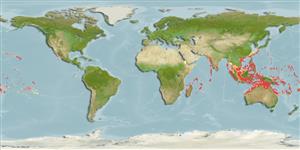Environment: milieu / climate zone / depth range / distribution range
Ecología
marino; salobre asociado a arrecife; rango de profundidad 1 - 80 m (Ref. 90102). Tropical; 35°N - 25°S
Pacific Ocean: northwest Australia, Moluccas, and Philippines to the Marquesan and Society islands, north to Ryukyu Islands, south to Rowley Shoals, Western Australia, and Tonga; Mariana and Caroline Islands in Micronesia.
Tamaño / Peso / Age
Maturity: Lm ? range ? - ? cm
Max length : 13.6 cm TL macho / no sexado; (Ref. 90102); common length : 10.4 cm SL macho / no sexado; (Ref. 37816)
Espinas dorsales (total) : 12; Radios blandos dorsales (total) : 9; Espinas anales: 3; Radios blandos anales: 5. Submarginal black band on inner pectoral fin surface complete; eyes relatively large; snout relatively short; hump on back less obvious as in S. diabolus; SL to 10.4 cm. No black spot nearly as large as eye on inner surface of pectoral fins. A narrow triangular black mark inside mouth at front of upper jaw behind teeth. Ascending process of premaxilla broad, its maximum width 1.4-1.8 in orbit diameter. No series papillae or nodules across interorbital space between supraocular spines. Nasal spine single (Ref 42181).
A rare inhabitant of mixed sand and rubble areas of reef flats and shallow lagoons. Feeds on fishes (Ref. 89972). Usually buries itself in the substrate when in sand or sits amongst rubble where it has good camouflage (Ref. 48635). Anterolateral glandular grooves with venom gland (Ref. 57406). Solitary or in pairs (Ref 90102).
Life cycle and mating behavior
Madurez | Reproducción | Puesta | Huevos | Fecundidad | Larva
Myers, R.F., 1991. Micronesian reef fishes. Second Ed. Coral Graphics, Barrigada, Guam. 298 p. (Ref. 1602)
IUCN Red List Status (Ref. 130435: Version 2024-1)
Human uses
Herramientas
Special reports
Download XML
Fuentes de Internet
Estimates based on models
Preferred temperature (Ref.
123201): 25 - 28.9, mean 27.7 °C (based on 672 cells).
Phylogenetic diversity index (Ref.
82804): PD
50 = 0.5000 [Uniqueness, from 0.5 = low to 2.0 = high].
Bayesian length-weight: a=0.01288 (0.00620 - 0.02676), b=3.03 (2.86 - 3.20), in cm total length, based on LWR estimates for this (Sub)family-body shape (Ref.
93245).
Nivel trófico (Ref.
69278): 3.9 ±0.7 se; based on size and trophs of closest relatives
Resiliencia (Ref.
120179): Alto, población duplicada en un tiempo mínimo inferior a 15 meses (Preliminary K or Fecundity.).
Fishing Vulnerability (Ref.
59153): Low vulnerability (10 of 100).
Nutrients (Ref.
124155): Calcium = 86.4 [42.3, 185.0] mg/100g; Iron = 0.783 [0.399, 1.637] mg/100g; Protein = 18.2 [16.1, 20.2] %; Omega3 = 0.272 [0.111, 0.722] g/100g; Selenium = 25.5 [12.1, 60.9] μg/100g; VitaminA = 249 [79, 763] μg/100g; Zinc = 1.67 [1.10, 2.46] mg/100g (wet weight);
